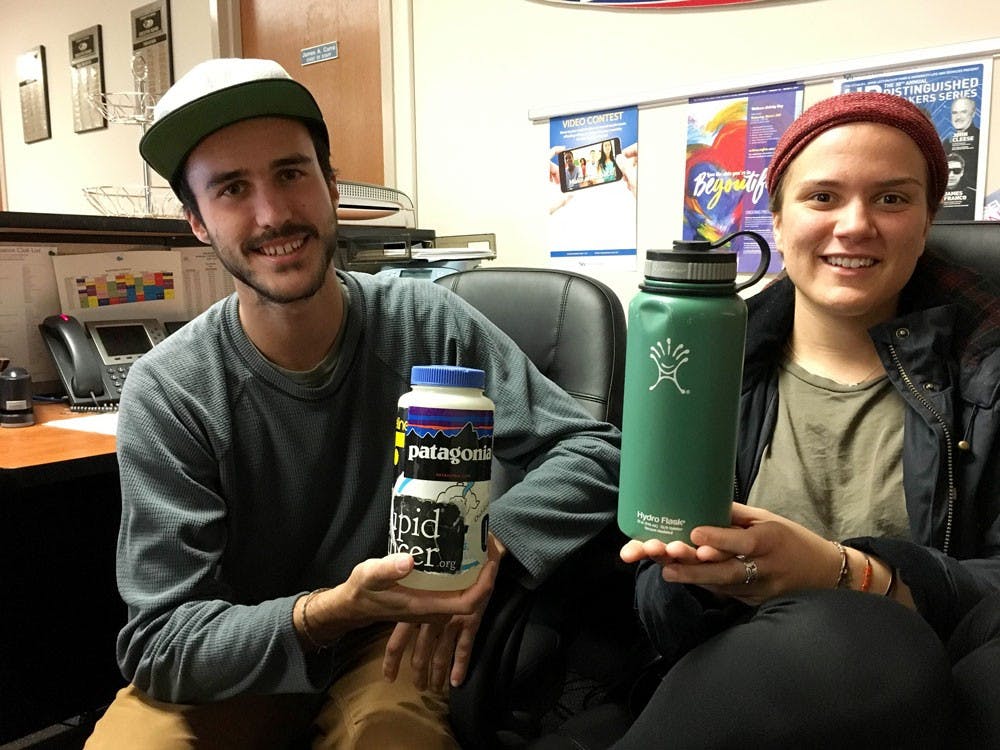If Anna Heintzman forgets to bring a water bottle to school, it’s going to be a bad day.
Heintzman, a senior business major, carries a reusable water bottle throughout the day and is hard-pressed to buy plastic if she can avoid it.
From the trendy S’well to the classic Nalgene, greener, cheaper alternatives to plastic bottles are gaining traction with students. Some students feel there is a heightened awareness about the health benefits to drinking water, encouraged by the refilling stations scattered throughout campus.
Another reason for the water bottle boom is cost. Students say it’s much cheaper for them to buy one or two reusable bottles and refill them for free, rather than pay $2 every time they’re thirsty.
One thing is clear: there is a reusable water bottle for every personality and lifestyle out there. Here’s a rundown of the different kinds and why students like them.
Glass
Although a bit heavier, glass bottles are safe from BPA, PVC and other contaminants linked to plastic wear. Glass water bottles also offer a sleek look and many come with silicone or gel-like sleeves to protect them from breaking. Most brands, from Lululemon to Camelback, carry some version of glass bottles.
Moumita Hore, a freshman physics major, said she tries to avoid eating or drinking from plastic containers as much as possible to limit exposure to these contaminants.
She carries a glass water bottle purchased from Wegmans to drink from each day.
“Drinking enough water is actually very difficult, like in order to see the physical effects in your skin and body, you have to drink even when you’re not thirsty which can be hard,” Hore said.
Hore strives to get in enough water a day without having to buy plastic bottles or drink from a water fountain by carrying her glass bottle.
Infusers
Serina Janczen, a freshman business major, said she can’t have her water without citrus fruit in it. She refills her purple plastic Camelback several times throughout the day in order to stay hydrated, something she feels is important to feel good and take care of herself.
A special bottle isn’t necessary to flavor water with fruit or spices, but several brands do make infusers, a separate piece in the bottle that holds fruit or other enhancers. The Ad-n-Art glass bottle is available for $21 and comes with a fruit infuser to keep the water flavorful, but free from floating strawberry or cucumber.
S’trendy
The S’well bottle is arguably becoming the most popular water bottle at the moment. The stainless steel bottles are triple-walled and come in a variety of sizes and designs, from their distinct wood collection to the sleek marble-like elements collection.
The bottles are narrow enough for easy transport and, in the spirit of International Women’s Day, buying from S’well supports the fastest-growing woman-run company in the U.S.
Pro tip: their largest size, the 24 oz. bottle, holds exactly one bottle of wine, according to their website.
Outdoorsy
Brian Johnson, a senior communication major, thinks plastic water bottles are “dumb” and “incredibly wasteful.”
“I’m too thirsty to deal with refilling one water bottle and there are so many [plastic water bottle] companies out there and they’re all selling the same thing, so I don’t get it, how do you decide which one,” Johnson said.
Johnson prefers his vintage Nalgene for everyday use and hiking. The plastic, Patagonia sticker-laden bottle is a hand-me-down from his father.
Heintzman brings her Nalgene for hikes and other outdoor activities. Because these bottles are relatively cheap, she doesn’t worry about them getting scuffed or dirty.
For Johnson and Heintzman, stickers for their bottles are almost as important as the water itself.
“You take stickers from national parks you go to and we [Outdoor Adventure Club] have stickers, it’s a very personal thing, it’s very cool,” Heintzman said.
Conventional wisdom has always been to drink eight glasses of water a day, but newer research shows that was meant as more of a guideline than a medical rule, according to Kathleen M. Zelman, nutritional director of WebMD. Even if the proper amount is less than eight glasses, drinking water throughout the day is still healthful. It aids with digestion and functions almost like a “liquid nutrient.”
Sarah Crowley is the senior features editor and can be reached at sarah.crowley@ubspectrum.com





